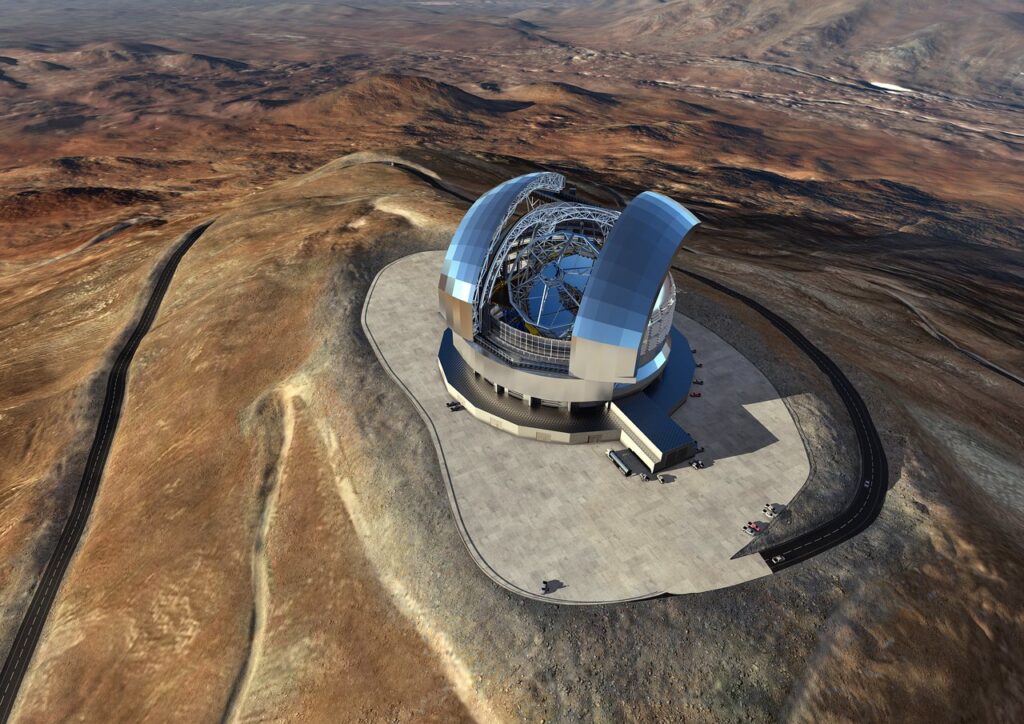

The last piece of the world’s largest telescope mirror has been cast successfully. This represents another important milestone for the Extremely Large Telescope project in Chile. Slated to be completed in the next decade, the ESO-operated ELT will be the world’s biggest telescope, with a main mirror of an impressive, unprecedented diameter of more than 39 meters. This mirror comprises 798 precisely manufactured hexagonal segments; due to the size of the mirror, each segment is roughly 1.5 meters in diameter and five-centimeters thick.
Constructed in the driest desert area on Earth—the Atacama Desert, which offers perfect conditions for astronomical observations due to minimal atmospheric interference—the ELT is one such colossal, international effort at the very frontier of astronomy. The recent success of SCHOTT, a German company, in producing the final blank for the 949 segments needed to make up the primary mirror (M1) of the telescope highlights both the precision and scope required for this task.
M1 forms the backbone of ELT observational capability through the collection and focusing of light from faint celestial objects; it does this with unsurpassed sensitivity. In addition to the 798 operational segments, a further 133 have been manufactured for re-coating the above-mentioned segments once the working life of the telescope commences. However, ESO obtains 18 replacement segments to ensure operational continuity and resilience against unexpected events.
Key to the production of these mirror segments is ZERODUR,’ a glass-ceramic material specially developed for SCHOTT with extremely low thermal expansion—property critical for withstanding extreme temperature fluctuations in the Atacama Desert. In the process, every single segment is shaped and polished to optical precision down to nanometer-scale tolerances so as not to lose any of the scientific performance of the telescope.
Working together with ESO, SCHOTT had the option to adjust the entire process in such a way that every single ZERODUR blank would meet these demanding specifications that would be required to achieve the challenging objectives of the ELT. “The manufacture of more than 230 tons of these special mirror substrates requires not only careful attention to detail but real commitment to excellence, which was observed throughout at SCHOTT,” says Marc Cayrel, head of ELT Optomechanics at ESO.
Thomas Werner is optimistic about the size of the project, calling it the biggest single order of ZERODUR® in the history of SCHOTT. This also accomplished another milestone in pushing the boundaries of astronomy and was the overthrow of a dedicated team in shaping the future of astronomy with technological innovation.
The story of every single mirror segment, from the production line to the assembly, becomes one of international cooperation and precision engineering. Shaped and polished at the facilities of SCHOTT, the segments enter their final processing at Safran Reosc in France, where they are sawed into hexagonal shapes and further polished to optical quality at the sub-nanometer level for them to become fully prepared for the envisaged operation, making each segment ready to seamlessly contribute to the imaging capabilities of the ELT.
The ELT project also extends to the mirror segments themselves, along with several international partners and suppliers. Dutch VDL ETG Projects BV produces supports for the segments that tightly hold them in place to maintain precise alignment and stability. The FAMES consortium, German-French, is developing advanced sensors to monitor the precise positioning of each segment with nanometric accuracy—required for ensuring optimal performance during observations by the telescope.
German company Physik Instrumente has supplied top-class actuators that will position each segment with extreme accuracy, advancing the operational competencies of the ELT. Danish logistics firm DSV manages complex transport logistics, ensuring safe delivery of segments from production facilities to the ELT Technical Facility at ESO’s Paranal Observatory in Chile over a journey of more than 10,000 kilometers.
It is when they finally arrive at Paranal that each mirror segment gets a final coating of silver that makes it reflective and an official part of the ELT optical system. These coated segments will form part of most far-from-risk storage until the construction of the main structure of the telescope is finished, after which they will be fitted into the assembly of the ELT.
The new operation phase that the ELT will enter is bound to be disruptive for observational astronomy. It will be able to take up some of the deepest astronomical questions of our time and uncover new knowledge of the cosmos. Deemed to start observations later this decade, the ELT shall be a testament to human ingenuity and international collaboration, setting the scene for unprecedented discoveries to expand our understanding of the universe.
The successful realization of the Extremely Large Telescope is more than a technological achievement; rather, it marks an epoch in the very long history of evolution in observational astronomy. With its enormous primary mirror, tailor-made with 798 segments, the ELT is bound to transform the study of the cosmos at an utterly new level of detail. With light-gathering power tens of millions of times greater than the human eye, the telescope can unveil distant galaxies, explore the birth of stars and planets, and reach into the mysteries of dark matter and dark energy.
Moreover, the site of the ELT in the Atacama Desert—a region of clear and dark skies—is very conductive for astronomical observations. The dry climate and high altitude of the desert produce extremely stable atmospheric conditions, one of the most critical elements to achieve high resolution and sensitive spectroscopic analysis. In this alone, the setting dictates that the ELT would be a vital facility for astronomy worldwide, one that will further humankind’s understanding of the basic processes accompanying the cosmos.
This final casting of the ELT’s main mirror is an evocative milestone in a journey towards unfolding all mysteries of the universe. The future of scientific collaboration and approach—driven by international cooperation—shall find an ideal launch pad within the new age of discovery, propelling humankind forward.
Source: SciTechDaily
Also Read: The Impact of Body Shape on Dementia and Parkinson’s
Exploring Aging: Can Protein Aggregates Predict Age-Associated Diseases?

